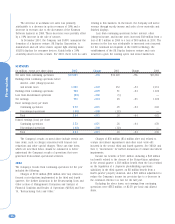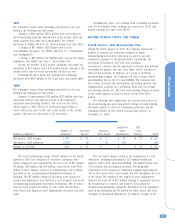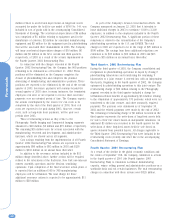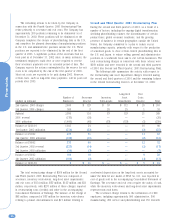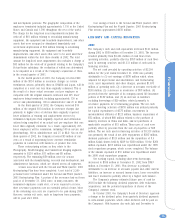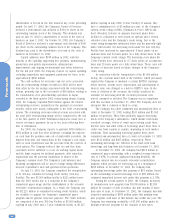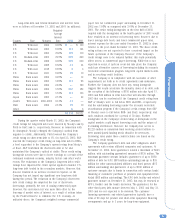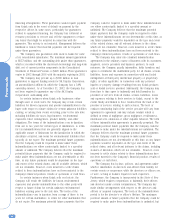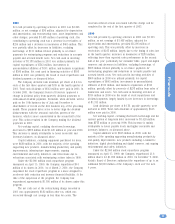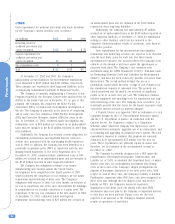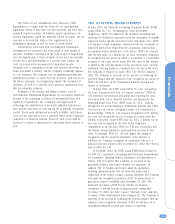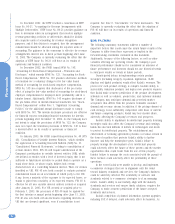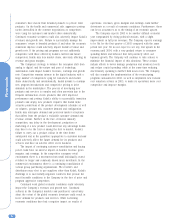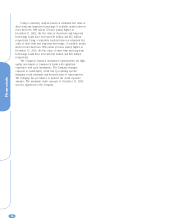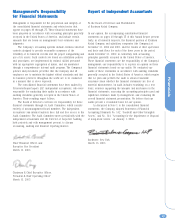Kodak 2002 Annual Report Download - page 30
Download and view the complete annual report
Please find page 30 of the 2002 Kodak annual report below. You can navigate through the pages in the report by either clicking on the pages listed below, or by using the keyword search tool below to find specific information within the annual report.
Financials
30
property holding company and an arrangement to purchase spare
parts. After entering into these arrangements, the Company
obtained the documentation and specifications of the parts it
sourced solely from the Vendor and a comprehensive supplier list
for the parts the Vendor sourced from other suppliers. However,
under these arrangements, Kodak had a use restriction, which
precluded the Company from manufacturing the parts that the
Vendor produced and from purchasing parts directly from the
Vendor’s suppliers. This use restriction would be effective until
certain triggering events occurred, the most significant of which
was the filing for bankruptcy by the Vendor. As indicated above,
the Vendor filed for bankruptcy on December 24, 2002. The
arrangements that the Company entered into with the Vendor are
currently being reviewed in the bankruptcy courts, and there is
the possibility that such agreements could be challenged.
However, the Company believes that it has a strong legal position
with respect to the agreements and is taking the necessary steps
to obtain the rights to gain access to the Vendor’s tooling to
facilitate the manufacture of the parts previously produced by the
Vendor. Additionally, the Company has begun to source parts
directly from the Vendor’s suppliers. Accordingly, the Company
does not anticipate any significant liability arising from the
inability to fulfill its service obligations under the arrangement
with ESF.
In December 2001, S&P downgraded the credit ratings of
Dana Corporation to BB for long-term debt and B for short-term
debt, which are below investment grade. This action created a
Guarantor Termination Event under the Receivables Purchase
Agreement (RPA) between ESF and its banks. To cure the
Guarantor Termination Event, in January 2002, ESF posted $60
million of additional collateral in the form of cash and long-term
lease receivables. At that time, if Dana Corporation were
downgraded to below BB by S&P or below Ba2 by Moody’s, that
action would constitute a Termination Event under the RPA and
ESF would be forced to renegotiate its debt arrangements with
the banks. On February 22, 2002, Moody’s downgraded Dana
Corporation to a Ba3 credit rating, thus creating a Termination
Event.
Effective April 15, 2002, ESF cured the Termination Event
by executing an amendment to the RPA. Under the amended RPA,
the maximum borrowings have been lowered to $400 million, and
ESF must pay a higher interest rate on outstanding and future
borrowings. Additionally, if there were certain changes in control
with respect to Dana Corporation or DCC, as defined in the
amended RPA, such an occurrence would constitute an event of
default. Absent a waiver from the banks, this event of default
would create a Termination Event under the amended RPA. The
amended RPA arrangement was further amended in July 2002 to
extend through July 2003. Under the amended RPA arrangement,
maximum borrowings were reduced to $370 million. Total
outstanding borrowings under the RPA at December 31, 2002
were $320 million.
Dana Corporation’s S&P and Moody’s long-term debt credit
ratings have remained at the February 22, 2002 levels of BB and
Ba3, respectively. Under the amended RPA, if either of Dana
Corporation’s long-term debt ratings were to fall below their
current respective ratings, such an occurrence would create a
Termination Event as defined in the RPA.
The amended RPA arrangement extends through July 2003,
at which time the RPA can be extended or terminated. If the RPA
were terminated, Qualex would no longer be able to sell its lease
receivables to ESF and would need to find an alternative
financing solution for future sales of its photofinishing equipment.
For the year ended December 31, 2002, total sales of
photofinishing equipment were $3.5 million. Under the partnership
agreement between Qualex and DCC, subject to certain
conditions, ESF has exclusivity rights to purchase Qualex’s long-
term lease receivables. The term of the partnership agreement
continues through October 6, 2003. In light of the timing of the
partnership termination, Qualex plans to utilize the services of
Eastman Kodak Credit Corporation, a wholly owned subsidiary of
General Electric Capital Corporation, as an alternative financing
solution for prospective leasing activity with its customers.
At December 31, 2002, the Company had outstanding letters
of credit totaling $105 million and surety bonds in the amount of
$79 million primarily to ensure the completion of environmental
remediations and payment of possible casualty and workers’
compensation claims.
As of December 31, 2002, the impact that our contractual obligations are expected to have on our liquidity and cash flow in
future periods is as follows:
(in millions) Total 2003 2004 2005 2006 2007 2008+
Long-term debt obligations $ 1,551 $ 387 $ 285 $ 332 $ 500 $ — $ 47
Operating lease obligations 355 102 72 56 42 32 51
Purchase obligations 1,159 265 239 205 116 77 257
Total $ 3,065 $ 754 $ 596 $ 593 $ 658 $ 109 $ 355


